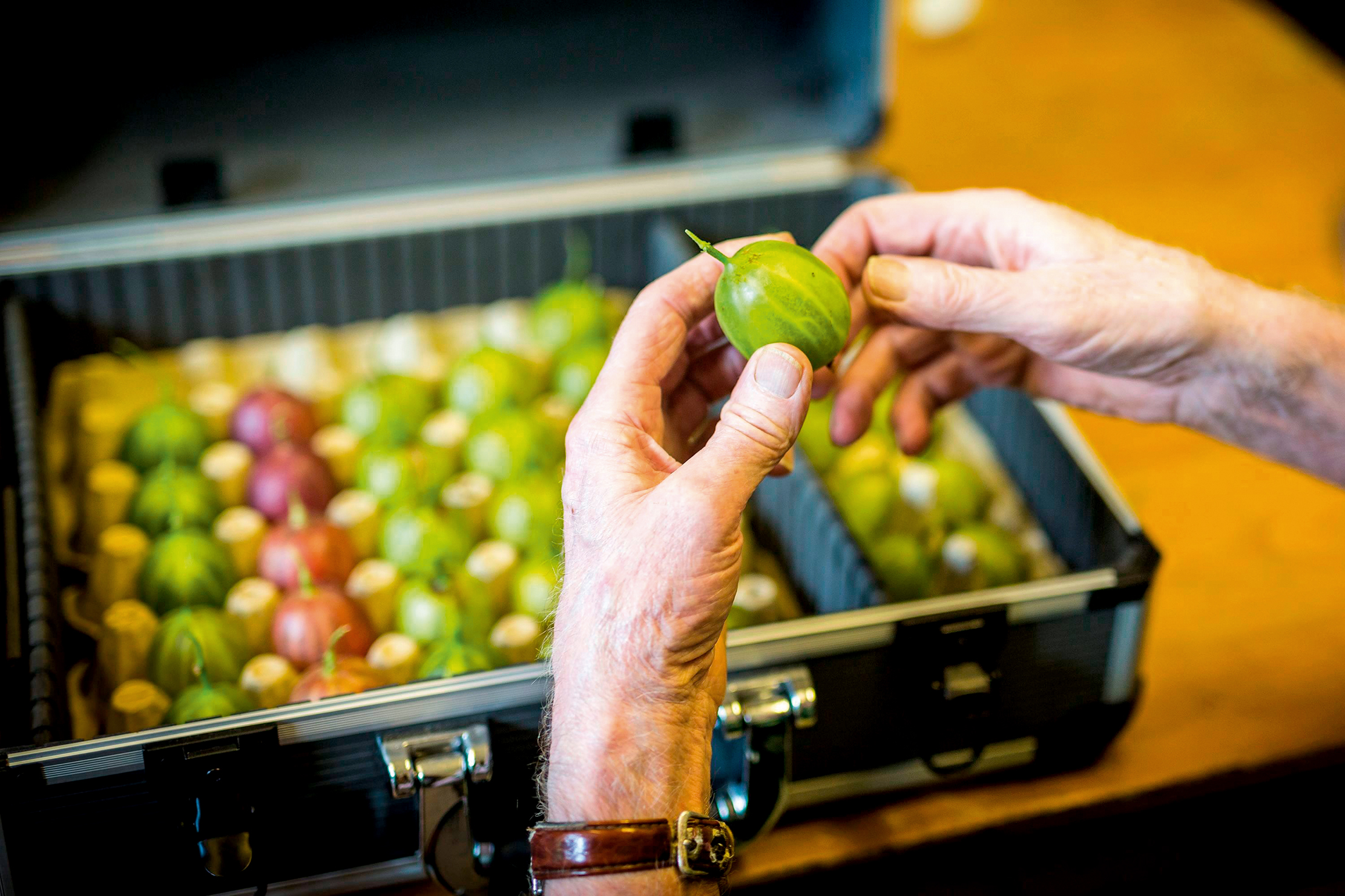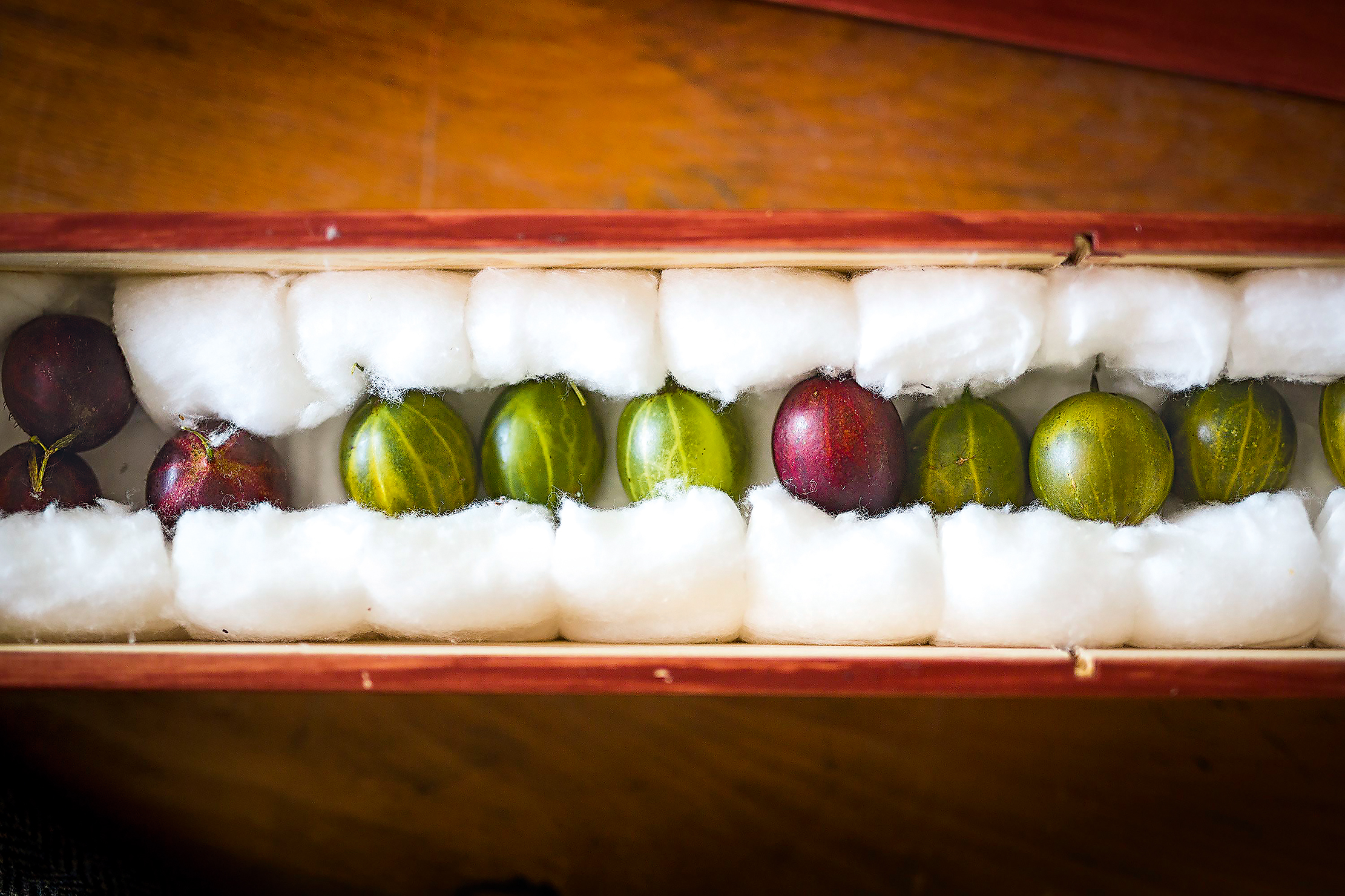How to grow a giant gooseberry, and other top tips from the 219th Egton Bridge Old Gooseberry Show
Ahead of this week's Egton Bridge Old Gooseberry Show, Steven Desmond spoke to competitors at this centuries-old event.

Below, is his report on this wonderfully eccentric institution — which includes tips on growing from Graeme Watson, who won the coveted Champion Berry award this year for the 10th time in his career.
Egton Bridge is a quiet spot tucked away down steep hills and winding lanes a few miles inland from Whitby on the North Yorkshire coast. The sandstone cottages and pubs overlook the rattling River Esk deep in its shady green valley, below the dark tracts of heather moorland all around.
All this seems an unlikely setting for a horticultural show of international fame, but, on the first Tuesday in August each year, as for more than two centuries past, gardeners and exhibitors will bring their boxes of treasured fruits to the village.
On that day, the Stape Silver Band entertains the many visitors who wait patiently outside while the judges in the school hall examine the entries at the Egton Bridge Old Gooseberry Show.
The judges’ task here is a relatively straightforward one, as the prize is awarded to the heaviest fruit in each class, with scant regard to any other qualities. However, those who feel suddenly tempted by the prospect of easy prize tickets should heed the groans of disbelief from the experienced — there’s more to this business than meets the eye.
We know that this ancient society was founded in 1800, simply because the Whitby Gazette recorded the results of the Centenary Show in 1900. Although gooseberry shows are a minority pursuit today, this was far from the case in the early years. Such shows had been popular at least since the mid 18th century, especially among independent craftworkers throughout Lancashire and Yorkshire and the adjacent Midland counties.
Numbers reached their peak in the second half of the 19th century, with more than 170 shows listed. Most were in the industrial towns, with several societies in Sheffield alone. Although Egton Bridge seems the exact opposite of an industrial settlement today, it lies on the Esk Valley railway line, built with great difficulty and expense from Whitby to Middlesbrough during just those dynamic years.
Sign up for the Country Life Newsletter
Exquisite houses, the beauty of Nature, and how to get the most from your life, straight to your inbox.
The gooseberry boom in the North was followed by an equally dramatic bust. By 1896, the number of shows had shrunk to 73 and, 20 years later, to eight. The gooseberry show seemed to have gone the way of the boneshaker and the spoon-warmer, except that, instead of fading politely away, those last few societies have simply carried on as if the events of history had not occurred.

There are, today, 10 gooseberry societies, each with its own show. Nine are in a triangle of Cheshire bounded by Congleton, Macclesfield and Northwich and the 10th 150 miles away in little Egton Bridge.
No one in these parts can offer any satisfactory explanation for this splendid isolation. This being North Yorkshire, although conscious of their heritage, the growers are more interested in getting on with it and doing things properly. There’s no shortage of entrants to the show each year and the immense catalogue of past statistics shows a gradual upward trend in the weight of the winning berries.
One such exhibitor is Graeme Watson, whose gooseberry pens on a hillside at nearby Ainthorpe are a picture of exemplary cultivation. The bushes are grown in their own pens, or cages, enclosed by see-through walls of micromesh, fine enough to exclude even aphids. The plants themselves are amply spaced in loamy soil improved by working in plenty of organic matter over the years and dressed with bark chippings for a practical surface.
The choice of cultivar is one that exercises the mind of every competitor. The names of favourite kinds have remained remarkably consistent down the years: although Woodpecker is the overall favourite nowadays, others from past ages still grace the winning lists, including evocative names such as Hero of the Nile, Blücher and Lord Kitchener.
Mr Watson wisely advises the would-be entrant to come to the show and see what does best on the day. The desired forms are widely available from a number of local nurseries, including the well-known R. V. Roger of Pickering, which keeps a list of 90 to choose from.
There are many ways of achieving the desired result. Some exhibitors are more than willing to discuss their methods, but others shy away from yielding dark secrets. Some stick to time-honoured traditions and others favour scientific order and method. As Mr Watson, ten times champion following his victory in 2019, will tell you, good gardening and attention to detail will get results in the end.
Weather is always a major factor on this high moorland — it’s subject to high rainfall, sudden storms, plenty of snow and frequent fogs — but that affects all comers. As the Whitby Gazette observed at the 1895 show, low weights that year were due to ‘recent heavy rains’, whereas, at the 1899 event, the same phenomenon was due to ‘the droughty weather’. Those who are defeated will always have their reasons.
While the band works through its repertoire, the judges do their work. Each fruit is weighed on an Avery scale purchased for the purpose in 1937 and used ever since. The weights are graded in drams and grains, meticulously observed and recorded around the table. The condition of each fruit is of no consequence unless it’s both split and weeping — in which case, it’s set aside.

This business of splitting, or bursting, is a vexed one. The heaviest fruit is bound to be the one with the most liquid in it, but getting it from the garden to the show along uneven moorland roads with sheep in the middle of them is a treacherous business. Some are found punctured on the morning of the show by an uncaring wasp.
The fruits typically arrive in egg boxes, with the additional comfort of a lining of cotton wool. Some competitors use the extra protection of a hinged wooden box specially made for the purpose. Even so, accidents will happen.
When the results are declared and the public pile in, the winning entries and prizes are neatly set out along the bench, with flowering pot plants down the centre to add refinement. There are classes for the various colours: yellow often does best, but red, white and humble green are also recognised. There are also classes for twins (joined on the same stalk), heaviest six, heaviest 12 and the four colours, with separate classes for maiden, or novice, exhibitors.
Everyone wants to see the main draw, however, which is the Champion Berry — and in 2019 it was Mr Watson who took the glory with a world record-breaking gooseberry weighing in at just over two and a quarter ounces.
The prizes displayed alongside the fruits have always been useful domestic items rather than shiny medals. In 1899, they included a silver-plated teapot, a set of blankets and a copper kettle. For one brief moment in 1974, a sponsor donated a greenhouse, but this extravagance was never repeated. Nowadays, garden tools are favoured — you might as well come away with something useful.
Once the prizes are removed, the band packs up and hands are shaken all round. There is a universal feeling that this is a worthy tradition that survives because it has a life and vigour of its own, not as an antiquarian pursuit.
As the then chairman, Eric Preston, explained on the society’s bicentenary, ‘the prestige of winning is very great. One is therefore a member of an exclusive band’.
The 219th Egton Bridge Old Gooseberry Show was held on Tuesday, August 6. For more details, including how to enter next year, visit www.egtongooseberryshow.org.uk

Country Life Today: The 'Holy Grail' of gooseberries has been grown in Yorkshire

Credit: Melanie Johnson
Slow-roasted, gooseberry-stuffed rolled pork belly with gooseberry relish
Gooseberries should be enjoyed in both savoury and in sweet dishes.
-
 Two quick and easy seasonal asparagus recipes to try this Easter Weekend
Two quick and easy seasonal asparagus recipes to try this Easter WeekendAsparagus has royal roots — it was once a favourite of Madame de Pompadour.
By Melanie Johnson
-
 Sip tea and laugh at your neighbours in this seaside Norfolk home with a watchtower
Sip tea and laugh at your neighbours in this seaside Norfolk home with a watchtowerOn Cliff Hill in Gorleston, one home is taller than all the others. It could be yours.
By James Fisher